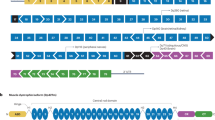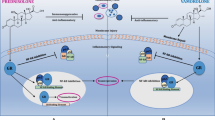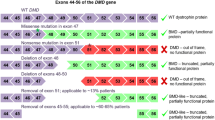Abstract
Duchenne muscular dystrophy (DMD) is a lethal heritable childhood myodegenerative condition caused by a mutation within the gene encoding the dystrophin protein within the X chromosome. While, historically, patients with this condition rarely lived into their thirties, they are now living substantially longer as a result of new treatments based on multi-disciplinary care. Despite these advances, the prognosis for DMD patients is limited, and a progressive reduction in quality of life and early death in adulthood cannot be prevented using currently available treatment regimens. The best hopes for a cure lies with cellular and gene therapy approaches that target the underlying genetic defect. In the past several years, viral and nonviral gene therapy methodologies based on adeno-associated viruses, naked plasmid delivery, antisense oligonucleotides, and oligonucleotide-mediated gene editing have advanced to a high degree of sophistication, to the extent that research has moved from the laboratory setting to the clinic. Notwithstanding these accomplishments, shortcomings with each therapy remain, so more work is required to devise an appropriate therapeutic strategy for the management and eventual cure of this debilitating disease.

Similar content being viewed by others
References
Emery AE. Muscular dystrophy into the new millennium. Neuromuscul Disord 2002 May; 12(4): 343–9
Rando TA. Non-viral gene therapy for Duchenne muscular dystrophy: progress and challenges. Biochim Biophys Acta 2007 Feb; 1772(2): 263–71
Peault B, Rudnicki M, Torrente Y, et al. Stem and progenitor cells in skeletal muscle development, maintenance, and therapy. Mol Ther 2007 May; 15(5): 867–77
Blankinship MJ, Gregorevic P, Chamberlain JS. Gene therapy strategies for Duchenne muscular dystrophy utilizing recombinant adeno-associated virus vectors. Mol Ther 2006 Feb; 13(2): 241–9
Arahata K, Engel AG. Monoclonal antibody analysis of mononuclear cells in myopathies: I. Quantitation of subsets according to diagnosis and sites of accumulation and demonstration and counts of muscle fibers invaded by T cells. Ann Neurol 1984 Aug; 16(2): 193–208
Griggs RC, Moxley RT, Mendell JR, et al. Prednisone in Duchenne dystrophy: a randomized, controlled trial defining the time course and dose response. Clinical Investigation of Duchenne Dystrophy Group. Arch Neurol 1991 Apr; 48(4): 383–8
Mendell JR, Moxley RT, Griggs RC, et al. Randomized, double-blind six-month trial of prednisone in Duchenne’s muscular dystrophy. N Engl J Med 1989 Jun 15; 320(24): 1592–7
Moxley RT, Ashwal S, Pandya S, et al. Practice parameter: corticosteroid treatment of Duchenne dystrophy: report of the Quality Standards Subcommittee of the American Academy of Neurology and the Practice Committee of the Child Neurology Society. Neurology 2005 Jan 11; 64(1): 13–20
Balaban B, Matthews DJ, Clayton GH, et al. Corticosteroid treatment and functional improvement in Duchenne muscular dystrophy: long-term effect. Am J Phys Med Rehabil 2005 Nov; 84(11): 843–50
Kinali M, Mercuri E, Main M, et al. An effective, low-dosage, intermittent schedule of prednisolone in the long-term treatment of early cases of Duchenne dystrophy. Neuromuscul Disord 2002 Oct; 12Suppl. 1: S169–74
Wagner KR, Lechtzin N, Judge DP. Current treatment of adult Duchenne muscular dystrophy. Biochim Biophys Acta 2007 Feb; 1772(2): 229–37
McDonald DG, Kinali M, Gallagher AC, et al. Fracture prevalence in Duchenne muscular dystrophy. Dev Med Child Neurol 2002 Oct; 44(10): 695–8
Simonds AK. Respiratory complications of the muscular dystrophies. Semin Respir Crit Care Med 2002 Jun; 23(3): 231–8
Mohr CH, Hill NS. Long-term follow-up of nocturnal ventilatory assistance in patients with respiratory failure due to Duchenne-type muscular dystrophy. Chest 1990 Jan; 97(1): 91–6
Simonds AK, Muntoni F, Heather S, et al. Impact of nasal ventilation on survival in hypercapnic Duchenne muscular dystrophy. Thorax 1998 Nov; 53(11): 949–52
Vianello A, Bevilacqua M, Salvador V, et al. Long-term nasal intermittent positive pressure ventilation in advanced Duchenne’s muscular dystrophy. Chest 1994 Feb; 105(2): 445–8
Finder JD, Birnkrant D, Carl J, et al. Respiratory care of the patient with Duchenne muscular dystrophy: ATS consensus statement. Am J Respir Crit Care Med 2004 Aug 15; 170(4): 456–65
Bach JR, Ishikawa Y, Kim H. Prevention of pulmonary morbidity for patients with Duchenne muscular dystrophy. Chest 1997 Oct; 112(4): 1024–8
Nigro G, Comi LI, Politano L, et al. The incidence and evolution of cardiomyopathy in Duchenne muscular dystrophy. Int J Cardiol 1990 Mar; 26(3): 271–7
Nohria A, Lewis E, Stevenson LW. Medical management of advanced heart failure. JAMA 2002 Feb 6; 287(5): 628–40
Pfeffer MA, Braunwald E, Moye LA, et al. Effect of captopril on mortality and morbidity in patients with left ventricular dysfunction after myocardial infarction: results of the survival and ventricular enlargement trial. The SAVE Investigators. N Engl J Med 1992 Sep 3; 327(10): 669–77
Pitt B, Poole-Wilson PA, Segal R, et al. Effect of losartan compared with captopril on mortality in patients with symptomatic heart failure: randomised trial — the Losartan Heart Failure Survival Study ELITE II. Lancet 2000 May 6; 355(9215): 1582–7
Alton E. Progress and prospects: gene therapy clinical trials (part 1). Gene Ther 2007 Oct; 14(20): 1439–47
Duboc D, Meune C, Pierre B, et al. Perindopril preventive treatment on mortality in Duchenne muscular dystrophy: 10 years’ follow-up. Am Heart J 2007 Sep; 154(3): 596–602
Duboc D, Meune C, Lerebours G, et al. Effect of perindopril on the onset and progression of left ventricular dysfunction in Duchenne muscular dystrophy. J Am Coll Cardiol 2005 Mar 15; 45(6): 855–7
Gradaus R, Wollmann C, Kobe J, et al. Potential benefit from implantable cardioverter-defibrillator therapy in children and young adolescents. Heart 2004 Mar; 90(3): 328–9
Gao G, Vandenberghe LH, Wilson JM. New recombinant serotypes of AAV vectors. Curr Gene Ther 2005 Jun; 5(3): 285–97
Gregorevic P, Blankinship MJ, Allen JM, et al. Systemic delivery of genes to striated muscles using adeno-associated viral vectors. Nat Med 2004 Aug; 10(8): 828–34
Wang Z, Zhu T, Qiao C, et al. Adeno-associated virus serotype 8 efficiently delivers genes to muscle and heart. Nat Biotechnol 2005 Mar; 23(3): 321–8
Gregorevic P, Allen JM, Minami E, et al. rAAV6-microdystrophin preserves muscle function and extends lifespan in severely dystrophic mice. Nat Med 2006 Jul; 12(7): 787–9
Harper SQ, Hauser MA, DelloRusso C, et al. Modular flexibility of dystrophin: implications for gene therapy of Duchenne muscular dystrophy. Nat Med 2002 Mar; 8(3): 253–61
England SB, Nicholson LV, Johnson MA, et al. Very mild muscular dystrophy associated with the deletion of 46% of dystrophin. Nature 1990 Jan 11; 343(6254): 180–2
Mirabella M, Galluzzi G, Manfredi G, et al. Giant dystrophin deletion associated with congenital cataract and mild muscular dystrophy. Neurology 1998 Aug; 51(2): 592–5
Liu M, Yue Y, Harper SQ, et al. Adeno-associated virus-mediated microdystrophin expression protects young mdx muscle from contraction-induced injury. Mol Ther 2005 Feb; 11(2): 245–56
Yoshimura M, Sakamoto M, Ikemoto M, et al. AAV vector-mediated microdystrophin expression in a relatively small percentage of mdx myofibers improved the mdx phenotype. Mol Ther 2004 Nov; 10(5): 821–8
Watchko J, O’Day T, Wang B, et al. Adeno-associated virus vector-mediated minidystrophin gene therapy improves dystrophic muscle contractile function in mdx mice. Hum Gene Ther 2002 Aug 10; 13(12): 1451–60
Ghosh A, Yue Y, Duan D. Viral serotype and the transgene sequence influence overlapping adeno-associated viral (AAV) vector-mediated gene transfer in skeletal muscle. J Gene Med 2006 Mar; 8(3): 298–305
Ghosh A, Yue Y, Long C, et al. Efficient whole-body transduction with trans-splicing adeno-associated viral vectors. Mol Ther 2007 Apr; 15(4): 750–5
Lai Y, Yue Y, Liu M, et al. Efficient in vivo gene expression by trans-splicing adeno-associated viral vectors. Nat Biotechnol 2005 Nov; 23(11): 1435–9
McCarty DM, Young Jr SM, Samulski RJ. Integration of adeno-associated virus (AAV) and recombinant AAV vectors. Annu Rev Genet 2004; 38: 819–45
Louboutin JP, Wang L, Wilson JM. Gene transfer into skeletal muscle using novel AAV serotypes. J Gene Med 2005 Apr; 7(4): 442–51
Schmidt M, Katano H, Bossis I, et al. Cloning and characterization of a bovine adeno-associated virus. J Virol 2004 Jun; 78(12): 6509–16
Blouin V, Brument N, Toublanc E, et al. Improving rAAV production and purification: towards the definition of a scaleable process. J Gene Med 2004 Feb; 6Suppl. 1: S223–8
University of North Carolina at Chapel Hill, Gene Therapy Center. Clinical trials: Duchenne muscular dystrophy clinical trial [online]. Available from URL: http://genetherapy.unc.edu/clinical.htm [Accessed 2008 Feb 28]
Safety study of mini-dystrophin gene to treat Duchenne muscular dystrophy. Trial identifier: NCT00428935 [online]. Available from URL: http://clinicaltrials.gov/ct2/show/NCT00428935 [Accessed 2008 Feb 28]
Wolff JA, Malone RW, Williams P, et al. Direct gene transfer into mouse muscle in vivo. Science 1990 Mar 23; 247: 1465–8
Bartlett RJ, Secore SL, Singer JT, et al. Long-term expression of a fluorescent reporter gene via direct injection of plasmid vector into mouse skeletal muscle: comparison of human creatine kinase and CMV promoter expression levels in vivo. Cell Transplant 1996 May–Jun; 5(3): 411–9
Wells DJ, Maule J, McMahon J, et al. Evaluation of plasmid DNA for in vivo gene therapy: factors affecting the number of transfected fibers. J Pharm Sci 1998 Jun; 87(6): 763–8
Acsadi G, Dickson G, Love DR, et al. Human dystrophin expression in mdx mice after intramuscular injection of DNA constructs. Nature 1991 Aug 29; 352(6338): 815–8
Romero NB, Braun S, Benveniste O, et al. Phase I study of dystrophin plasmid-based gene therapy in Duchenne/Becker muscular dystrophy. Hum Gene Ther 2004 Nov; 15(11): 1065–76
Taniyama Y, Tachibana K, Hiraoka K, et al. Development of safe and efficient novel nonviral gene transfer using ultrasound: enhancement of transfection efficiency of naked plasmid DNA in skeletal muscle. Gene Ther 2002 Mar; 9(6): 372–80
Danialou G, Comtois AS, Dudley RW, et al. Ultrasound increases plasmid-mediated gene transfer to dystrophic muscles without collateral damage. Mol Ther 2002 Nov; 6(5): 687–93
Lu QL, Liang HD, Partridge T, et al. Microbubble ultrasound improves the efficiency of gene transduction in skeletal muscle in vivo with reduced tissue damage. Gene Ther 2003 Mar; 10(5): 396–405
Bekeredjian R, Chen S, Frenkel PA, et al. Ultrasound-targeted microbubble destruction can repeatedly direct highly specific plasmid expression to the heart. Circulation 2003 Aug 26; 108(8): 1022–6
Mir LM, Bureau MF, Gehl J, et al. High-efficiency gene transfer into skeletal muscle mediated by electric pulses. Proc Natl Acad Sci U S A 1999 Apr 13; 96(8): 4262–7
Aihara H, Miyazaki J. Gene transfer into muscle by electroporation in vivo. Nat Biotechnol 1998 Sep; 16(9): 867–70
Andre F, Mir LM. DNA electrotransfer: its principles and an updated review of its therapeutic applications. Gene Ther 2004 Oct; 11Suppl. 1: S33–42
Wong SH, Lowes KN, Quigley AF, et al. DNA electroporation in vivo targets mature fibres in dystrophic mdx muscle. Neuromuscul Disord 2005 Oct; 15(9-10): 630–41
Murakami T, Nishi T, Kimura E, et al. Full-length dystrophin cDNA transfer into skeletal muscle of adult mdx mice by electroporation. Muscle Nerve 2003 Feb; 27(2): 237–41
Ferrer A, Foster H, Wells KE, et al. Long-term expression of full-length human dystrophin in transgenic mdx mice expressing internally deleted human dystrophins. Gene Ther 2004 Jun; 11(11): 884–93
Lefesvre P, Attema J, van Bekkum D. A comparison of efficacy and toxicity between electroporation and adenoviral gene transfer. BMC Mol Biol 2002 Aug 13; 3: 19
Schertzer JD, Plant DR, Lynch GS. Optimizing plasmid-based gene transfer for investigating skeletal muscle structure and function. Mol Ther 2006 Apr; 13(4): 795–803
Molnar MJ, Gilbert R, Lu Y, et al. Factors influencing the efficacy, longevity, and safety of electroporation-assisted plasmid-based gene transfer into mouse muscles. Mol Ther 2004 Sep; 10(3): 447–55
Mennuni C, Calvaruso F, Zampaglione I, et al. Hyaluronidase increases electrogene transfer efficiency in skeletal muscle. Hum Gene Ther 2002 Feb 10; 13(3): 355–65
McMahon JM, Signori E, Wells KE, et al. Optimisation of electrotransfer of plasmid into skeletal muscle by pretreatment with hyaluronidase: increased expression with reduced muscle damage. Gene Ther 2001 Aug; 8(16): 1264–70
Danialou G, Comtois AS, Matecki S, et al. Optimization of regional intraarterial naked DNA-mediated transgene delivery to skeletal muscles in a large animal model. Mol Ther 2005 Feb; 11(2): 257–66
Liang KW, Nishikawa M, Liu F, et al. Restoration of dystrophin expression in mdx mice by intravascular injection of naked DNA containing full-length dystrophin cDNA. Gene Ther 2004 Jun; 11(11): 901–8
Zhang G, Ludtke JJ, Thioudellet C, et al. Intraarterial delivery of naked plasmid DNA expressing full-length mouse dystrophin in the mdx mouse model of duchenne muscular dystrophy. Hum Gene Ther 2004 Aug; 15(8): 770–82
Hagstrom JE, Hegge J, Zhang G, et al. A facile nonviral method for delivering genes and siRNAs to skeletal muscle of mammalian limbs. Mol Ther 2004 Aug; 10(2): 386–98
Bertoni C, Jarrahian S, Wheeler TM, et al. Enhancement of plasmid-mediated gene therapy for muscular dystrophy by directed plasmid integration. Proc Natl Acad Sci U S A 2006 Jan 10; 103(2): 419–24
Prior TW, Bridgeman SJ. Experience and strategy for the molecular testing of Duchenne muscular dystrophy. J Mol Diagn 2005 Aug; 7(3): 317–26
Bertoni C, Rando TA. Dystrophin gene repair in mdx muscle precursor cells in vitro and in vivo mediated by RNA-DNA chimeric oligonucleotides. Hum Gene Ther 2002 Apr 10; 13(6): 707–18
Bertoni C, Morris GE, Rando TA. Strand bias in oligonucleotide-mediated dystrophin gene editing. Hum Mol Genet 2005 Jan 15; 14(2): 221–33
Rando TA, Disatnik MH, Zhou LZ. Rescue of dystrophin expression in mdx mouse muscle by RNA/DNA oligonucleotides. Proc Natl Acad Sci U S A 2000 May 9; 97(10): 5363–8
Bertoni C, Lau C, Rando TA. Restoration of dystrophin expression in mdx muscle cells by chimeraplast-mediated exon skipping. Hum Mol Genet 2003 May 15; 12(10): 1087–99
Mann CJ, Honeyman K, Cheng AJ, et al. Antisense-induced exon skipping and synthesis of dystrophin in the mdx mouse. Proc Natl Acad Sci USA 2001 Jan 2; 98(1): 42–7
Lu QL, Mann CJ, Lou F, et al. Functional amounts of dystrophin produced by skipping the mutated exon in the mdx dystrophic mouse. Nat Med 2003 Aug; 9(8): 1009–14
Alter J, Lou F, Rabinowitz A, et al. Systemic delivery of morpholino oligonucleotide restores dystrophin expression bodywide and improves dystrophic pathology. Nat Med 2006 Feb; 12(2): 175–7
Fletcher S, Honeyman K, Fall AM, et al. Dystrophin expression in the mdx mouse after localised and systemic administration of a morpholino antisense oligonucleotide. J Gene Med 2006 Feb; 8(2): 207–16
Fletcher S, Honeyman K, Fall AM, et al. Morpholino oligomer-mediated exon skipping averts the onset of dystrophic pathology in the mdx mouse. Mol Ther 2007 Sep; 15(9): 1587–92
Aartsma-Rus A, Bremmer-Bout M, Janson AA, et al. Targeted exon skipping as a potential gene correction therapy for Duchenne muscular dystrophy. Neuromuscul Disord 2002 Oct; 12Suppl. 1: S71–7
Wilton SD, Fall AM, Harding PL, et al. Antisense oligonucleotide-induced exon skipping across the human dystrophin gene transcript. Mol Ther 2007 Jul; 15(7): 1288–96
Aartsma-Rus A, Janson AA, Kaman WE, et al. Therapeutic antisense-induced exon skipping in cultured muscle cells from six different DMD patients. Hum Mol Genet 2003 Apr 15; 12(8): 907–14
Aartsma-Rus A, Janson AA, Kaman WE, et al. Antisense-induced multiexon skipping for Duchenne muscular dystrophy makes more sense. Am J Hum Genet 2004 Jan; 74(1): 83–92
Aartsma-Rus A, Janson AA, van Ommen GJ, et al. Antisense-induced exon skipping for duplications in Duchenne muscular dystrophy. BMC Med Genet 2007; 8: 43
Arechavala-Gomeza V, Graham IR, Popplewell LJ, et al. Comparative analysis of antisense oligonucleotide sequences for targeted skipping of exon 51 during dystrophin pre-mRNA splicing in human muscle. Hum Gene Ther 2007 Sep; 18(9): 798–810
van Deutekom JC, Janson AA, Ginjaar IB, et al. Local dystrophin restoration with antisense oligonucleotide PRO051. N Engl J Med 2007 Dec 27; 357(26): 2677–86
Takeshima Y, Yagi M, Wada H, et al. Intravenous infusion of an antisense oligonucleotide results in exon skipping in muscle dystrophin mRNA of Duchenne muscular dystrophy. Pediatr Res 2006 May; 59(5): 690–4
Howard M, Frizzell RA, Bedwell DM. Aminoglycoside antibiotics restore CFTR function by overcoming premature stop mutations. Nat Med 1996 Apr; 2(4): 467–9
Barton-Davis ER, Cordier L, Shoturma DI, et al. Aminoglycoside antibiotics restore dystrophin function to skeletal muscles of mdx mice. J Clin Invest 1999 Aug; 104(4): 375–81
Wagner KR, Hamed S, Hadley DW, et al. Gentamicin treatment of Duchenne and Becker muscular dystrophy due to nonsense mutations. Ann Neurol 2001 Jun; 49(6): 706–11
Welch EM, Barton ER, Zhuo J, et al. PTC124 targets genetic disorders caused by nonsense mutations. Nature 2007 May 3; 447(7140): 87–91
Hirawat S, Welch EM, Elfring GL, et al. Safety, tolerability, and pharmacokinetics of PTC124, a nonaminoglycoside nonsense mutation suppressor, following single- and multiple-dose administration to healthy male and female adult volunteers. J Clin Pharmacol 2007 Apr; 47(4): 430–44
Safety and efficacy study of PTC124 in Duchenne muscular dystrophy. Trial identifier: NCT00264888 [online]. Available from URL: http://clinicaltrials.gov/ct2/show/NCT00264888 [Accessed 2008 Feb 28]
Acknowledgments
The authors would like to thank Dr Vahab Soleimani for careful reading and criticism of the manuscript.
No sources of funding were used to assist in the preparation of this review. The authors have no conflicts of interest that are directly relevant to the content of this review.
Author information
Authors and Affiliations
Corresponding author
Rights and permissions
About this article
Cite this article
Scimè, A., Rudnicki, M.A. Molecular-Targeted Therapy for Duchenne Muscular Dystrophy. Mol Diag Ther 12, 99–108 (2008). https://doi.org/10.1007/BF03256275
Published:
Issue Date:
DOI: https://doi.org/10.1007/BF03256275




